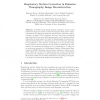Free Online Productivity Tools
i2Speak
i2Symbol
i2OCR
iTex2Img
iWeb2Print
iWeb2Shot
i2Type
iPdf2Split
iPdf2Merge
i2Bopomofo
i2Arabic
i2Style
i2Image
i2PDF
iLatex2Rtf
Sci2ools
MICCAI
2005
Springer
2005
Springer
Respiratory Motion Correction in Emission Tomography Image Reconstruction
In Emission Tomography imaging, respiratory motion causes artifacts in lungs and cardiac reconstructed images, which lead to misinterpretations and imprecise diagnosis. Solutions like respiratory gating, correlated dynamic PET techniques, list-mode data based techniques and others have been tested with improvements over the spatial activity distribution in lungs lesions, but with the disadvantages of requiring additional instrumentation or discarding part of the projection data used for reconstruction. The objective of this study is to incorporate respiratory motion correction directly into the image reconstruction process, without any additional acquisition protocol consideration. To this end, we propose an extension to the Maximum Likelihood Expectation Maximization (MLEM) algorithm that includes a respiratory motion model, which takes into account the displacements and volume deformations produced by the respiratory motion during the data acquisition process. We present results from...
Medical Imaging | MICCAI 2005 | Respiratory Motion | Respiratory Motion Correction | Respiratory Motion Model |
| Added | 15 Nov 2009 |
| Updated | 15 Nov 2009 |
| Type | Conference |
| Year | 2005 |
| Where | MICCAI |
| Authors | Mauricio Reyes, Grégoire Malandain, Pierre Malick Koulibaly, Miguel Ángel González Ballester, Jacques Darcourt |
Comments (0)

